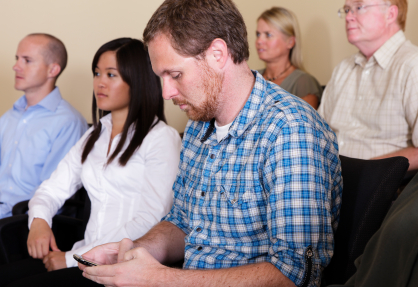Managing A Distracted Audience: The Multitasking Myth
I occasionally write in the evenings at my family’s kitchen table. Sometimes, my wife pops in the room and asks me a question. I stop typing, look up, and say, “Sorry, what was that?”
That scene probably plays out in millions of homes all over the world each night. As one partner reads a book, performs a household repair, or prepares the children for bed, the other partner asks a question that barely gets heard.
The truth is we’re terrible multitaskers. You may have deceived yourself into believing that you’re somehow different—that you can easily focus on numerous tasks, giving each equal energy, simultaneously. But the brain science is rather unambiguous on this point: you can’t.
That has consequences for you each time you speak to an audience. That man who is checking his smartphone for incoming emails can’t also be giving you his full attention. That woman live-tweeting the event can’t also be giving you her full attention. So what’s a speaker to do in such a distracted age?

First, the science. Dr. John Medina, the director of the Brain Center for Applied Learning Research at Seattle Pacific University and the author of Brain Rules, writes:
“The brain cannot multitask. Multitasking, when it comes to paying attention, is a myth. The brain naturally focuses on concepts sequentially, one at a time…To put it bluntly, research shows that we can’t multitask. We are biologically incapable of processing information-rich inputs simultaneously…Studies show that a person who is interrupted takes 50 percent longer to accomplish a task. Not only that, he or she makes up to 50 percent more errors.”
Susan Weinschenk, a psychologist and author of 100 Things Every Presenter Needs To Know About People, agrees:
“The term multitasking is a misnomer. People can’t actually do more than one task at a time. Instead, we switch tasks…You make more errors when you switch than when you do one task at a time. If the tasks are complex, then those time and error penalties increase.”
As a presenter, what can you do to prevent your audience from multitasking by sneaking regular peeks at their cell phones and emails?
First, take a look at an earlier post I wrote on this topic, called “Five Ways To Handle Smartphone Distractions During a Speech.”

But I want to go beyond the advice I’ve offered in the past by suggesting that you consider introducing a “cell phone-free zone” or “wireless-free zone” for your next talk.
Now, I already hear many of you objecting to that idea, and you’re right that doing so isn’t permissible in many public speaking settings (if you’re pitching a product to a potential client, insisting they power down won’t win you many friends).
But think of these settings: a work meeting; an educational lecture; a hospital tour; an orientation course; a sensitivity training workshop. Those are just a few examples, but it gives you an idea of the times when you might be able to introduce a cell phone-free zone.
Since people sometimes freak out (internally, if not externally) when you take away their ability to check their phones, offer them a safety valve. Tell them you’ll have bathroom/cell phone breaks once every 60-90 minutes. And do explain why you’re requesting their compliance—not out of being power hungry, but out of a desire to have their full focus on the critical content they’re about to learn. You might even share some of the brain science about multitasking with them.
Finally, in settings in which people may be using their laptops or electronic devices to take notes, ask them to turn their wireless off. As the science shows, every “ping” from a new email serves as a distraction, no matter how momentary.
What do you think? Would you consider requesting a cell-free zone for your presentations? How would you react to a speaker who requested one from you? Please leave your thoughts in the comments section.



Any suggestions for presenting to a bunch of high school kids? I run a weekly debating club at a local high school and I’m astonished by how distractible these kids are. They aren’t using cellphones but they turn and chat with each other, gaze off into space and ask irrelevant questions (frequently, ones that I’ve answered already.)
I work hard to make the presentations interesting, and I’m careful to model good speaking behaviour by looking around the room and looking each of them in the eyes but I still feel as though I’m not getting 100% of their attention?
Am I being unrealistic? Are my standards too high? Or is there anything I could do to improve?
Daphne,
Thank you for your comment. One idea that comes immediately to mind is one described by Chip and Dan Heath in their great book “Made to Stick” (which I highly recommend).
They discuss the importance of exposing “knowledge gaps,” which create a bit of a puzzle for students to solve. The basic premise of their argument is that instead of giving people the relevant facts first, you create a riddle of sorts that exposes their knowledge gap first. So you might say, “Why is it that two out of three people sleep within arm’s reach of their cell phones? Is it because people are addicted? Does the phone rewire their brain? Do they just like being able to keep up to date when they wake up? Is sleeping near a smartphone just a form of human connection, similar to the warm feeling of sharing a bed with your mate?” Then, work the rest of the class to answer that question.
You’ll enjoy that book, and I suspect it will offer several new ideas.
Thanks for reading!
Brad
I attended a conference recently where the attendees were encouraged to a) take notes and b) tweet about the conference. The first was for our benefit, the second was good marketing for our hosts. But tweeting and paying attention at the same time were not so compatible.
I work with participants to set ground rules about phones up front. Sometimes they have to be available, but at least they can silence their phones. Often, a participant or the event’s sponsor will suggest that everyone turn off their phones—I love that, then they’re setting their own rules.
It’s a great plan to give folks a break every 60 to 90 minutes. I know I appreciate this as a participant, and this is especially helpful if the content is complex for the audience. If you set a pattern of giving them frequent breaks, they’ll accept being “unplugged” from their phones during the presentations.
Another thing that helps to discourage multi-tasking is to provide (and to elicit) a strong rationale for the presentation. If your participants are convinced (and especially if they convince themselves) that the content is valuable to them, then they will spend more less time doing distracting things. The more engagement, the more they will benefit from the presentation.
Jeanne,
Thanks for your comment.
You’ve put your finger on an important point — sometimes a distracted audience that’s tweeting about you and expanding your reach is a good thing for you. In those cases, a speaker might be willing to sacrifice full audience attention in order to gain additional reach. That’s a rational choice, but one that should be made with full awareness of the pros and cons.
I appreciate you reading the blog!
Best wishes,
Brad
Interesting post. As much as I am ashamed to admit it, I am completely guilty of not giving my undivided attention to presenters. I am a graduate student, so whether it is my professor speaking or guest lecturer, I constantly find myself so distracted by my smartphone. I think the point you make about creating a cell-free environment during presentations would definitely be a tough one, especially for me, but it would also be effective to a certain extent. If mobile devices do not distract audiences they will be more likely to give a presenter more attention. However, on the other hand, they may constantly be thinking of what notifications they are receiving on their phones instead of paying to the presenter. People have a fear of missing out, when they do not have their phones. A cell-free zone could work in two ways, be effective in capturing the audience’s undivided attention or generate anxiety for not having mobile devices and being able to check notifications.
Hi Ky,
Thank you very much for your comment.
You put your finger squarely on the dilemma facing presenters: If you allow audience members to look at their phones, they’ll be distracted. If you don’t, they may also be distracted.
Therefore, here’s my bottom line: Presenters who request a cell phone-free zone must grab their audience’s attention and sustain it through the entire session. Most of us can attend a play or a film without constantly checking our phones (at least I hope that’s still true), so it stands to reason that a compelling presenter should be able to make the audience forget their phones for a while.
Thanks for reading the blog!
Best,
Brad
Brad –
This is a great debate, and perhaps I’m simply being obstinate, but I think the key is to actually deliver a great presentation. So many people immediately go to their devices because the presentation is simply awful. And not eventually, immediately! We watched a CMO of a huge financial company lose his audience in less than :30 seconds. Why? Not because the audience possessed mobile devices, but because he didn’t hold up his end of the obligation. He didn’t create compelling stories, he didn’t structure the presentation in a clear, obvious format the audience could follow, he didn’t internalize his content, he didn’t engage.
Can’t blame the device, only the person. In my opinion, don’t ask for a phone-free space, just step up and do a great presentation!
THANKS
– Brian
Hi Brian,
Thanks for your comment. I don’t take you as being obstinate at all — it’s an important perspective worth being debated!
I generally agree with you, but I’d add a few points for consideration:
1. There are some corporate and institutional cultures in which interacting with a smartphone during a presentation is the norm. I’m thinking about academia as an example. I’ve had professors tell me that their students often sit down with a device in their hands, and even if a gorilla were to suddenly enter the room and traipse down the aisles, some students would be far too occupied to notice. That’s an extreme example, but it does suggest that even good speakers could be unable to attract audience attention at times.
2. People overestimate their ability to interact with their device and listen simultaneously. That’s one of the reasons I usually don’t like people live-tweeting my speeches. My preference is for people to be present and truly hear what I’m saying.
3. Related to that, even if people are serving my purposes by live-tweeting an event, whenever they go to their phones, they’re seeing breaking news push notifications, texts, messages, emails, @ mentions, and other distractors. All of those things take them away from me.
So while I generally agree with your premise, my argument is that it shouldn’t be an absolute. Some speaking engagements might warrant a cell-free zone, and I’d encourage speakers to consider whether any such moments might apply to them.
Thank you for writing! I love smart counterarguments and appreciate that you took the time to write one.
Best,
Brad